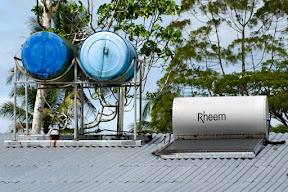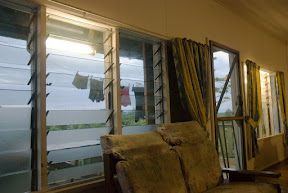Lowlands also means that the climate is hot and humid. The day usually starts with a cool 25˚C and 95% humidity, but in the late afternoon the thermometer climbs to 33˚C with the humidity falling to 70%. Only slowly we adapt to the fact that we are constantly sweating or at least feel sweaty.
 |
| Tropical Sunrise |
With this blog entry we would like to introduce you to our house and all the peculiarities that come with living in the tropics. The house itself is built on stilts, in order to keep it cool (with the air being able to flow all around it) and to keep the water out (the ground is usually very wet and soggy). And additionally, all the creepy crawlers so abundant around here cannot get in as easily (even though we still have plenty of them).
 |
| House in Stilts and Water Tanks |
Our water supply is solely based on rainwater, caught in gutters and directed into water tanks. However, in order to have enough water pressure to use a tap or the shower inside the house, the water first has to be pumped up to the roof into what is called header tanks. Fortunately, we have an electric pump that does the job for us. Since the water is coming right from the roof it is supposed to be drinkable straight from the tap. We still use a water filter, though. A look into the water tanks makes this decision easy.
 |
| Header Tank and Warm Water Solar Panel |
As far as warm water is concerned we are probably ahead of all developed nations. We are using solar energy to heat the water, though, the tank to store it is rather small and if the sun is not out during the day we might end up having a cold shower (yes, we are now starting to need warm showers from time to time).
Electricity is generated by a petrol generator owned by the hospital. It usually runs from 7am to 10pm unless the hospital has patients on oxygen, in which case the power stays on the whole night. For the rest of the time the house has a second wiring fed by a 12V-car-battery system similar to those used in mobile homes. So, we at least have some light when we get up before 7am. Some of our lighting is installed, not in the house, but outside the windows. This is to keep the bugs attracted by light where they belong – outside.
 |
| Light in Front of the Windows |
Whereas in most places we had lived up to now the main concern was how to keep a house warm, we now think about how to keep the house cool. Without air-conditioning, that is, because those machines consume a lot of energy, which is not available through the hospital’s small generator. Apart from stilts and constantly open windows we use ceiling vans, which are constantly turning (when we have power, that is). They keep the air circulating, which helps to keep things cooler. This constantly moving air also has another advantage: It helps keeping stuff from getting mouldy.
 |
| Hot Cupboard |
We have another means to prevent mould, however. It is the “hot cupboard”. As the name suggests this is a cupboard heated by a light bulb, thus reducing the humidity inside. So, every thing valuable like items made of leader, documents, paper, stationary, electronics, cameras, etc. are stored here.